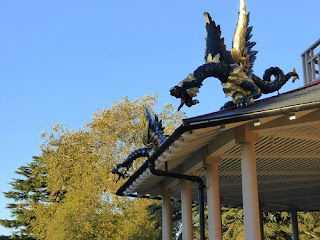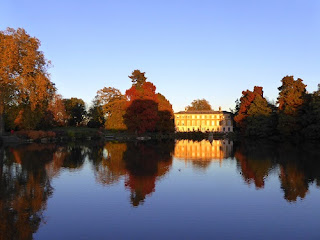From Richmond
to Strawberry Hill House to see
Horace Walpole's collection reunited in neo-Gothic surroundings
was the first of our excursions on what turned out to be a four-day staycation (had been planning to visit friends on the Greek island of Spetses, but prices for flights to Athens had gone through the roof).
Having read my Arts Desk colleague Sarah Kent on the new exhibition, and with happy memories of what happened when
Houghton Hall's dispersed collection - much of it sold by Horace's unbalanced nephew to Catherine the Great - came home, I thought it would make a jolly day out.
The weather helped - the most serene, sharp and perfect of Autumn days; we ate our lunch on a bench by the river at Richmond, and this was the view above our heads. Then we crossed the noble bridge and walked parallel to Ham House on the other side. It's hidden by trees, but that only makes the perspective with not a building in sight the more naturally beautiful.
Various trees framed the river at low tide
with sundry old boats and barges glinting through the leaves.
Architecturally, it's a string of pearls. While the river near home has grand houses along Chiswick Mall, none is as fine as Marble Hill House, the Palladian villa commissioned by Henrietta Howard, mistress of the then-future George II, and completed in 1729.
Until you reach the church at Twickenham,
the fine houses and grounds accumulate.
This is more like the Chiswick legacy, a home for an admiral.
No time, alas, to pause for homage to Pope at the church, but onwards to our exhibition slot at Strawberry Hill. Unfortunately the Thames Path goes inwards, along a busy road, but once at Walpole's retreat, the rusticity is resumed, with only the planes roaring overhead on their way to or from Heathrow to break the illusion.

In 1750, having rented a 'little play-thing-house' known as Strawberry Hill Shot, Horace Walpole (1717-97) wrote to his distant cousin and long-term correspondent Sir Horace Mann, 'I am going to build a little Gothic castle...If you can pick me up any fragments of old painted glass, arms or anything, I shall be excessively obliged to you' (I'm working my way through the somewhat disordered and patchy Everyman collection of his letters). The project grew, like Topsy, with additions made up to 1772, a combination - as now it still seems - of gallery and cosy home, full of 'gloomth' (Walpole's own portmanteau word): 'I did not mean to make my house so Gothic as to exclude convenience, and modern refinements in luxury'. With 'battlements for a roof', as he found authorised in Deuteronomy, Walpole made sure that the south facade would be 'the only side...at all regular'.

I had to photograph its upper half only, because in the first of many annoyances about the exhibition, and the general management of a house admittedly well restored, a tea-room marquee currently blots out an unobstructed view of the south front. From this point on, with no photography permitted within the house, I look elsewhere, including Strawberry Hill House's current management, for images. I trust 'fair use' applies for the diverse sources.
Walpole thought the hall and staircase 'the most particular and chief beauty of the castle'. But that was before John Chute designed the Library with details copied from Gothic tombs in Canterbury Cathedral and Westminster Abbey, illustrated here in 1781 by Edward Edwards
and then the Gallery, with its fan vaulting modelled on Henry VII's chapel, also in Westminster Abbey. 'Gilders, carvers, upholsterers and picture-cleaners are labouring at their several forges, and I do not love to trust a hammer or a brush without my own supervisal,' Walpole wrote in July 1763, a month before the gallery was completed.
The collection comes nowhere near the masterpieces of Houghton Hall (many now in St Petersburg's Hermitage), but the ensemble is fine. Printing, including 3D for a Gibbons frame, has been useful to fill in some of the gaps.
One gets the sense that Walpole was more interested in human idiosyncrasy as represented by the portrait than by great paintings (or maybe he couldn't afford those, though he did buy a superb Van Dyck double portrait for a remarkably low price). There are wonderful miniatures, though the bad exhibition lighting, poor throughout the house, prevents one from seeing them properly. Walpole didn't rate Hilliard as highly as the Olivers, but nonetheless this, of Sir Francis Drake, is a gem of the cabinet.
Noted is a penchant for beautiful young men, not least this boy as shepherd by Peter Lely
and Walpole's features were delicate. I love the portraits Rosalba Carriera painted of him and his cousin Francis Seymour Conway, Earl of Hertford, whom he met on his Grand Tour.
His Strawberry Hill parties were a byword in extravagance, though he seems to have been torn between his curiosity about people and the need for a quiet, solitary life. The
festino for a party including many French visitors in May 1769 is briefly described in a celebrated letter: 'At the gates of the castle I received them, dressed in the cravat of Gibbons's carving,
and a pair of gloves embroidered to the elbows that had belonged to James I.'
In addition, celebratory verses were printed on the Strawberry Hill press, their distribution inaugurated by 'French horns and clarionets'. 'In the evening we walked, had tea, coffee, and lemonade in the Gallery, which was illuminated with a thousand, or thirty candles, I forget which, and played at whisk and loo till midnight. Then there was a cold supper, and at one the company returned to town, saluted by fifty nightingales, who, as tenants of the manor, came to do honour to their lord...'
On the feminine side there is exquisite beauty in the collection's signature painting of the Ladies Waldegrave by Reynolds
and on the other hand - an odd purchase - Hogarth's portrait of the triple murderer Sarah Malcolm in her cell before execution. Hogarth made a fortune out of prints of this subject.
After that, some air. I can't say I entirely enjoyed the experience: the volunteer guides in every room just would not let you alone with your catalogue. I like to talk to them, but only if I have something to ask; these ones would collar you and insist you look at this or that. Way too intrusive. I only got away with private viewing in the bigger rooms where they were already having rather banal-sounding conversations with other members of the public.

And so, into the garden, which is no longer what Walpole wanted, something 'riant, and the gaiety of nature' in opposition to 'the gloomth of abbeys and cathedrals' imprinted on the house; a garden, he insisted, could not be Gothic. The lawns run into the territory of the adjoining St Mary's College, once part of the University of London, now St Mary's University. Its buildings look more like a hospital with a bit of grass in front, though the shell bench in what Walpole called his 'perfect Paphos' remains (or is it a copy? Anyway, the paint is peeling).
We wandered round the college demesne, the cries of the sporty reminding us that this is the demesne of rugger buggers. The chapel, though, is interesting, in extreme contrast to the house. Built in 1962-3 above the university library, its brick model is Albi Cathedral. The Sutherlandesque reredos is in fact by Constance Stubbs
and I like the glass by by the studios of Gabriel Loire, master glazier of Chartres Cathedral. This is the west window.
After a brief glimpse at Walpole's Chapel in the Woods, with poor Victorian muralling by way of overlay, we made our way back. Kew was a familiar destination for the next bright autumn afternoon, and what remains most vividly with me is the autumnal smells rising from the ground in the bosky groves. Out in the sunlight it was once again warm, and the delights began with the temple ensemble just inside the Victoria Gate.
I'd already admired the
renovated Temperate House and the
new dragons on the Pagoda on an October visit, and J was suitably impressed. We took a spin around the upper walkway, where the harmony between glass and iron above
and greenery from Australasia below
was most apparent. If the great height of many of the plants in the pre-renovated building has now been much reduced, the sense of light and space is overwhelmingly impressive.
Then to the pagoda
and its guardians.
The lower denizens are carved in cedar, like these three above and below; those higher up were achieved by more 3D printing.
On to the Japanese landscape around the Chokushi-Mon (Japanese Gateway), with live denizens this time. The purple berries behind them belong to
Callicarpa japonica.
The ailing but content other half then made his way back to the cafe while I took a semi-ritual route, down to the great red oak by the river opposite Syon House, tantalisingly labelled
Quercus X benderi Q. coccinea x Q. rubra,
enjoyed the deciduous firs by the lake
and the beech grove
before discovering rather two many mechanics being set up for the annual, moneymaking festival of light and heading back to the Victoria Gate via the Palm House, always vividly lit at sunset - no artificial lighting can surpass this -
and the view across to what's now called 'Museum No. 1'. Such resources on the doorstep.








































































